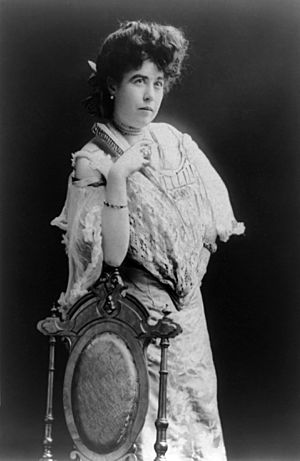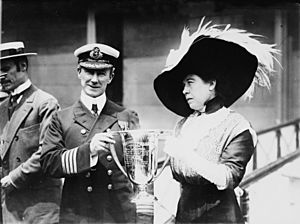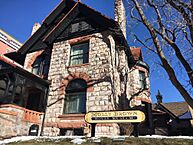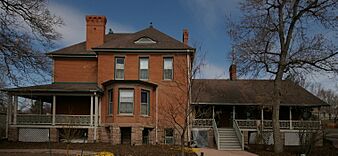Margaret Brown facts for kids
Quick facts for kids
Margaret Brown
|
|
|---|---|

Brown around the 1910s
|
|
| Born |
Margaret Tobin
July 18, 1867 Hannibal, Missouri, U.S.
|
| Died | October 26, 1932 (aged 65) New York City, U.S.
|
| Resting place | Cemetery of the Holy Rood, Westbury, New York, U.S. |
| Other names | Margaret Tobin Brown, Maggie Brown, Molly Brown, Mrs. James J. Brown |
| Occupation | Volunteer, philanthropist, and suffragist |
| Known for | Survivor of the Titanic sinking |
| Spouse(s) |
James Joseph Brown
(m. 1886; separated 1909) |
| Children | 2 |
| Parent(s) |
|
Margaret Brown (born Tobin; July 18, 1867 – October 26, 1932), is famously known as the "Unsinkable Molly Brown". She was an American who helped others and worked to improve society. She is best known for being a survivor of the RMS Titanic, which sank in 1912. After the ship sank, she urged the crew in her lifeboat to go back and look for more survivors in the water.
During her life, her friends called her "Maggie." After she died, newspapers started calling her the "Unsinkable Mrs. Brown." The nickname "Molly Brown" became popular after it was used in a book and newspapers.
Contents
Early Life and Family
Margaret Tobin was born on July 18, 1867, in a small cottage in Hannibal, Missouri. Today, her childhood home is a museum. Her parents, John and Johanna Tobin, were immigrants from Ireland. She grew up in a close-knit Irish community.
When she was 18, Margaret moved to Leadville, Colorado, with her brother and sister. She found a job in a store sewing carpets and curtains.
Marriage and Children

In Leadville, she met and married James Joseph Brown, who was called "J.J." He was not a rich man when they met, but Margaret married him for love. She once said she decided it was better to be with a poor man she loved than a rich man she did not.
Margaret and J.J. were married on September 1, 1886. They had two children: a son named Lawrence Palmer Brown (Larry) and a daughter named Catherine Ellen Brown (Helen).
From Poverty to Riches
In 1893, the Brown family became very wealthy. J.J. was a mining engineer, and his work helped discover a large amount of valuable ore in the Little Jonny Mine. His company rewarded him with shares of stock, which made the family rich.
In Leadville, Margaret helped miners' families by working in soup kitchens. After becoming wealthy, the Browns bought a large Victorian house in Denver in 1894. This house is now the Molly Brown House museum.
Margaret became a member of the Denver Woman's Club, which worked to improve women's lives through education and helping the community. She learned to speak several languages, including French, German, and Italian. She also worked hard to support women's right to vote.
After 23 years of marriage, Margaret and J.J. separated in 1909 but remained friends. She received a monthly allowance that allowed her to travel and continue her work for social causes.
A Fateful Voyage on the Titanic

In early 1912, Margaret was traveling in Europe. She was with her daughter and friends when she received a message that her grandson in Denver was sick. She immediately booked a ticket on the first ship sailing to New York, which happened to be the RMS Titanic. She boarded the ship on the evening of April 10.
The Sinking
On the night of April 14, 1912, the Titanic struck an iceberg. As the ship began to sink, Margaret helped other people get into the lifeboats. She had to be persuaded to leave the ship herself and finally got into Lifeboat No. 6.
In the lifeboat, she argued with the crewman in charge, Robert Hichens. Margaret wanted to go back to the debris field to rescue more people from the freezing water. Hichens was afraid that the lifeboat would be swamped or pulled down. After he refused several times, Margaret famously threatened to throw him overboard. Her bravery and determination to help others earned her the nickname "The Unsinkable Mrs. Brown."
Helping the Survivors

When the survivors were rescued by the ship RMS Carpathia, Margaret immediately started to help. She organized a committee with other first-class survivors to collect money and supplies for the less fortunate passengers from second and third class. She even helped comfort them and provide support.
Later Life and Helping Others
Margaret Brown's fame from the Titanic helped her promote causes she cared about. She continued to fight for the rights of workers and women.
In 1914, she ran for a seat in the U.S. Senate for Colorado. This was six years before women across the United States were guaranteed the right to vote. She stopped her campaign to go to France during World War I. There, she worked with the American Committee for Devastated France to help wounded soldiers and rebuild towns. For her incredible work, she was awarded the French Legion of Honor in 1932.
J.J. Brown died on September 5, 1922. Margaret said that she had "never met a finer, bigger, more worthwhile man than J.J. Brown."
Margaret Brown died in her sleep on October 26, 1932, at the age of 65. An autopsy later showed she had a brain tumor. She was buried next to her husband J.J. in Westbury, New York.
Legacy
Margaret Brown is remembered as a hero who was brave, caring, and determined. Her story continues to inspire people today.
- Museums: Her former home in Denver is now the Molly Brown House Museum. Her birthplace in Hannibal, Missouri, is also a museum.
- Honors: In 1985, she was added to the Colorado Women's Hall of Fame.
- In Popular Culture: The Disneyland Paris theme park has a riverboat attraction named the Molly Brown Riverboat. In 1965, astronauts Gus Grissom and John Young named their Gemini 3 spacecraft Molly Brown.
Portrayals in Movies and Plays
Margaret Brown's amazing life has been shown in many movies, TV shows, and plays. Some of the most famous portrayals include:
- Thelma Ritter (1953) in the movie Titanic.
- Debbie Reynolds (1964) in the movie musical The Unsinkable Molly Brown. Reynolds was nominated for an Academy Award for her role.
- Kathy Bates (1997) in the blockbuster movie Titanic.
See also
 In Spanish: Margaret Brown para niños
In Spanish: Margaret Brown para niños




